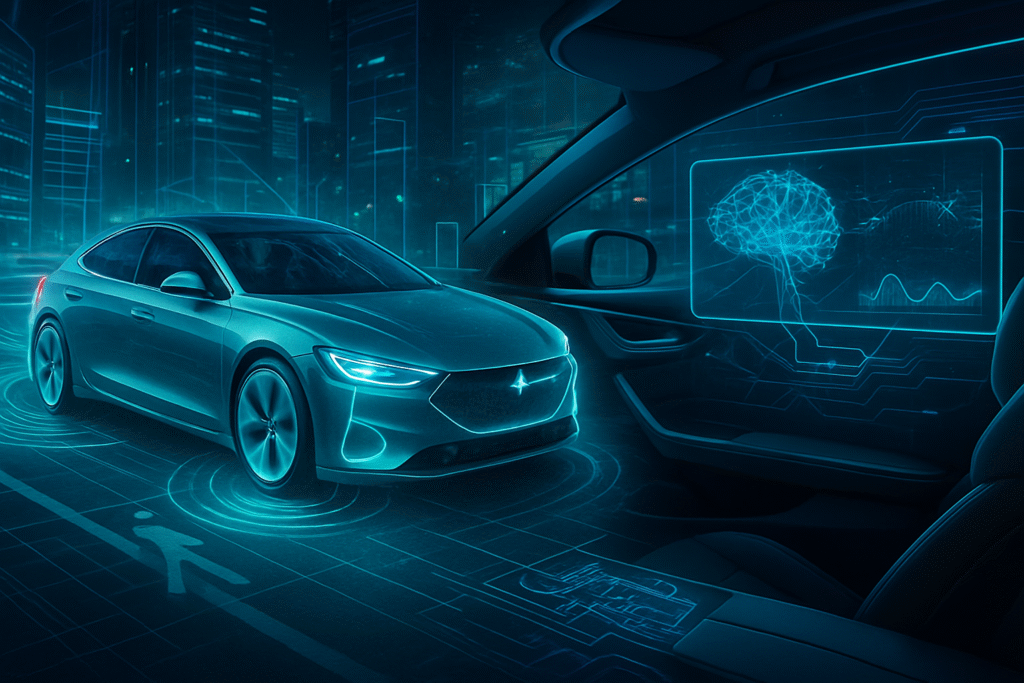
GENEVA – October 2, 2025 – STMicroelectronics (NYSE: STM) today announced a pivotal leap in automotive technology, commencing mass production of advanced car sensor systems. This significant development, spearheaded by an innovative interior sensing system developed in collaboration with Tobii, marks a critical milestone for the global semiconductor giant and the broader automotive industry. The move directly addresses the escalating demand for enhanced vehicle safety, sophisticated human-machine interfaces, and the foundational components necessary for the next generation of autonomous and semi-autonomous vehicles.
The interior sensing system, already slated for integration into a premium European carmaker's lineup, represents a powerful convergence of STMicroelectronics' deep expertise in imaging technology and Tobii's cutting-edge attention-computing algorithms. This rollout signifies not just a commercial success for STM but also a substantial advancement in making safer, smarter, and more intuitive vehicles a reality. As advanced sensor systems become the bedrock of future vehicles, this mass production initiative positions STMicroelectronics at the forefront of a rapidly expanding automotive semiconductor market, projected to reach over $77 billion by 2030.
Technical Prowess Driving the Next Generation of Automotive Intelligence
At the heart of STMicroelectronics' latest mass production effort is an advanced interior sensing system, engineered to simultaneously manage both Driver Monitoring Systems (DMS) and Occupant Monitoring Systems (OMS) using a remarkably efficient single-camera approach. This system leverages STMicroelectronics’ VD1940 image sensor, a high-resolution 5.1-megapixel device featuring a hybrid pixel design. This innovative design allows the sensor to be highly sensitive to both RGB (color) light for daytime operation and infrared (IR) light for robust performance in low-light or nighttime conditions, ensuring continuous 24-hour monitoring capabilities. Its wide-angle field of view is designed to cover the entire vehicle cabin, capturing high-quality images essential for precise monitoring. Tobii’s specialized algorithms then process the dual video streams, providing crucial data for assessing driver attention, fatigue, and occupant behavior.
This integrated single-camera solution stands in stark contrast to previous approaches that often required multiple sensors or more complex setups to achieve comparable functionalities. By combining DMS and OMS into a unified system, STMicroelectronics (NYSE: STM) offers carmakers a more cost-efficient, streamlined, and easier-to-integrate solution without compromising on performance or accuracy. Beyond this new interior sensing system, STMicroelectronics boasts a comprehensive portfolio of advanced automotive sensors already in high-volume production. This includes state-of-the-art vision processing units built on ST's proprietary 28nm FD-SOI technology, automotive radars for both short-range (24GHz) and long-range (77GHz) applications, and a range of high-performance CMOS image sensors such as the VG5661 and VG5761 global shutter sensors for driver monitoring. The company also supplies advanced MEMS sensors, GNSS receivers from its Teseo VI family for precise positioning, and Vehicle-to-Everything (V2X) communication technologies developed in partnership with AutoTalks. The initial reaction from the automotive research community and industry experts has been overwhelmingly positive, highlighting the system's potential to significantly enhance road safety and accelerate the development of more advanced autonomous driving features.
Reshaping the Competitive Landscape for AI and Tech Giants
STMicroelectronics' (NYSE: STM) entry into mass production of these advanced car sensor systems carries profound implications for a diverse array of companies across the AI and tech sectors. Foremost among the beneficiaries are the automotive original equipment manufacturers (OEMs) who are increasingly under pressure to integrate sophisticated safety features and progress towards higher levels of autonomous driving. Premium carmakers, in particular, stand to gain immediate competitive advantages by deploying these integrated, high-performance systems to differentiate their vehicles and meet stringent regulatory requirements.
The competitive implications for major AI labs and tech giants are significant. Companies like NVIDIA (NASDAQ: NVDA), Intel (NASDAQ: INTC), and Qualcomm (NASDAQ: QCOM), which are heavily invested in automotive computing platforms and AI for autonomous driving, will find their ecosystems further enriched by STMicroelectronics' robust sensor offerings. While STM provides the critical 'eyes' and 'ears' of the vehicle, these tech giants supply the 'brain' that processes the vast amounts of sensor data. This development could foster deeper collaborations or intensify competition in certain areas, as companies vie to offer the most comprehensive and integrated hardware-software solutions. Smaller startups specializing in AI-driven analytics for in-cabin experiences or advanced driver assistance stand to benefit from the availability of high-quality, mass-produced sensor data, enabling them to develop and deploy more accurate and reliable AI models. Conversely, companies relying on less integrated or lower-performance sensor solutions might face disruption, as the industry shifts towards more consolidated and advanced sensor packages. STMicroelectronics' strategic advantage lies in its vertically integrated approach and proven track record in automotive-grade manufacturing, solidifying its market positioning as a key enabler for the future of intelligent mobility.
Broader Implications for the AI Landscape and Automotive Future
The mass production of advanced car sensor systems by STMicroelectronics (NYSE: STM) is a pivotal development that seamlessly integrates into the broader AI landscape, particularly within the burgeoning field of edge AI and real-time decision-making. These sensors are not merely data collectors; they are sophisticated data generators that feed the complex AI algorithms driving modern vehicles. The ability to collect high-fidelity, multi-modal data (RGB, IR, radar, inertial) from both the external environment and the vehicle's interior is fundamental for the training and deployment of robust AI models essential for autonomous driving and advanced safety features. This development underscores the trend towards distributed intelligence, where AI processing is increasingly moving closer to the data source—the vehicle itself—to enable instantaneous reactions and reduce latency.
The impacts are far-reaching. On the safety front, the interior sensing system's ability to accurately monitor driver attention and fatigue is a game-changer, promising a significant reduction in accidents caused by human error, which accounts for a substantial portion of road fatalities. This aligns with global regulatory pushes, particularly in Europe, to mandate such systems. Beyond safety, these sensors will enable more personalized and adaptive in-cabin experiences, from adjusting climate control based on occupant presence to detecting child behavior for enhanced protection. Potential concerns, however, include data privacy—how this highly personal in-cabin data will be stored, processed, and secured—and the ethical implications of continuous surveillance within a private space. This milestone can be compared to previous AI breakthroughs in perception, such as advancements in object detection and facial recognition, but with the added complexity and safety-critical nature of real-time automotive applications. It signifies a maturation of AI in a domain where reliability and precision are paramount.
The Road Ahead: Future Developments and Expert Predictions
The mass production of advanced car sensor systems by STMicroelectronics (NYSE: STM) is not an endpoint but a catalyst for exponential future developments in the automotive and AI sectors. In the near term, we can expect to see rapid integration of these sophisticated interior sensing systems across a wider range of vehicle models, moving beyond premium segments to become a standard feature. This will be driven by both consumer demand for enhanced safety and increasingly stringent global regulations. Concurrently, the fusion of data from these interior sensors with external perception systems (radar, LiDAR, external cameras) will become more seamless, leading to more holistic environmental understanding for Advanced Driver-Assistance Systems (ADAS) and higher levels of autonomous driving.
Longer term, the potential applications are vast. Experts predict the evolution of "smart cabins" that not only monitor but also proactively adapt to occupant needs, recognizing gestures, voice commands, and even biometric cues to optimize comfort, entertainment, and productivity. These sensors will also be crucial for the development of fully autonomous Robotaxis and delivery vehicles, where comprehensive interior monitoring ensures safety and compliance without a human driver. Challenges that need to be addressed include the continuous improvement of AI algorithms to interpret complex human behaviors with higher accuracy, ensuring data privacy and cybersecurity, and developing industry standards for sensor data interpretation and integration across different vehicle platforms. What experts predict will happen next is a continued race for sensor innovation, with a focus on miniaturization, increased resolution, enhanced low-light performance, and the integration of more AI processing directly onto the sensor chip (edge AI) to reduce latency and power consumption. The convergence of these advanced sensor capabilities with ever more powerful in-vehicle AI processors promises to unlock unprecedented levels of vehicle intelligence and autonomy.
A New Era of Intelligent Mobility: Key Takeaways and Future Watch
STMicroelectronics' (NYSE: STM) announcement of mass production for its advanced car sensor systems, particularly the groundbreaking interior sensing solution developed with Tobii, marks a definitive turning point in the automotive industry's journey towards intelligent mobility. The key takeaway is the successful commercialization of highly integrated, multi-functional sensor technology that directly addresses critical needs in vehicle safety, regulatory compliance, and the foundational requirements for autonomous driving. This development underscores the growing maturity of AI-powered perception systems and their indispensable role in shaping the future of transportation.
This development's significance in AI history lies in its tangible impact on real-world, safety-critical applications. It moves AI beyond theoretical models and into the everyday lives of millions, providing a concrete example of how advanced computational intelligence can enhance human safety and convenience. The long-term impact will be a profound transformation of the driving experience, making vehicles not just modes of transport but intelligent, adaptive co-pilots and personalized mobile environments. As we look to the coming weeks and months, it will be crucial to watch for further announcements regarding vehicle models integrating these new systems, the regulatory responses to these advanced safety features, and how competing semiconductor and automotive technology companies respond to STMicroelectronics' strategic move. The race to equip vehicles with the most sophisticated "senses" is intensifying, and today's announcement firmly places STMicroelectronics at the forefront of this revolution.
This content is intended for informational purposes only and represents analysis of current AI developments.
TokenRing AI delivers enterprise-grade solutions for multi-agent AI workflow orchestration, AI-powered development tools, and seamless remote collaboration platforms.
For more information, visit https://www.tokenring.ai/.






